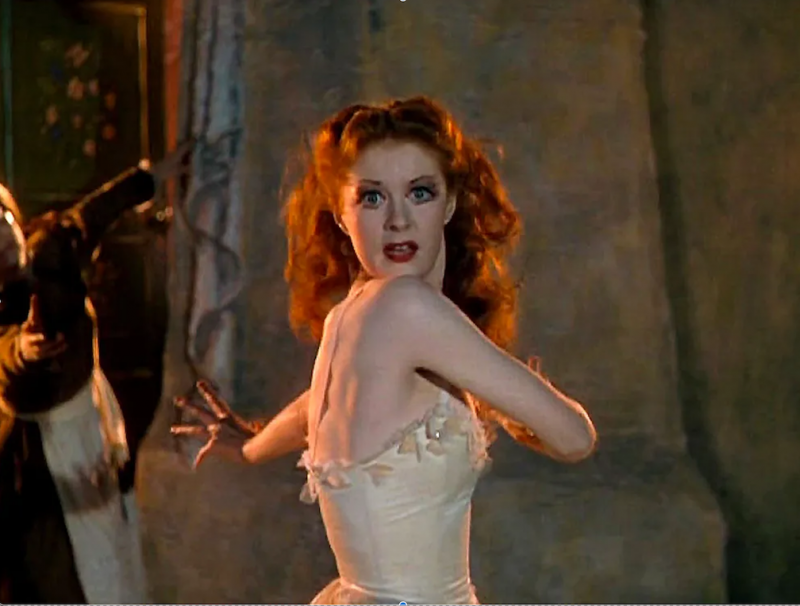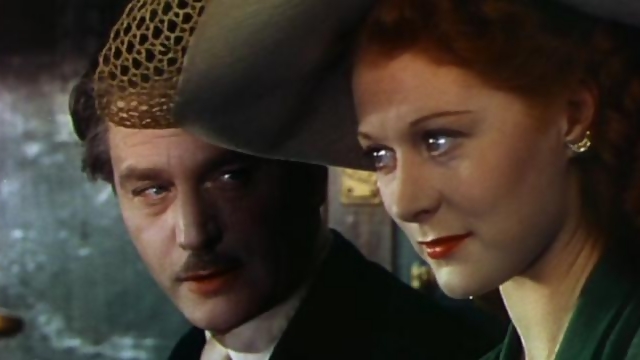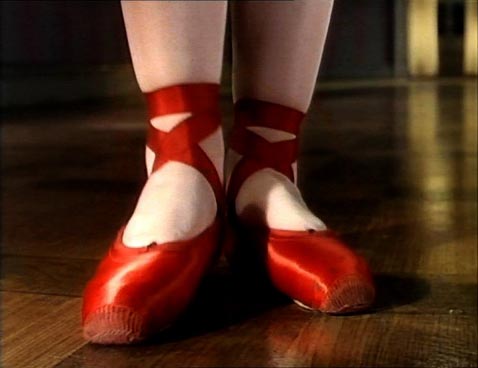Powell and Pressburger's 'The Red Shoes' - art and nothing but | reviews, news & interviews
Powell and Pressburger's 'The Red Shoes' - art and nothing but
Powell and Pressburger's 'The Red Shoes' - art and nothing but
The indelible ballet classic was the Archers' first attempt at a 'composed' film

Nobody ever forgets The Red Shoes (1948) because it’s a movie that seems to change the way an audience experiences cinema. A story about a diverse group of individuals collaborating to make art, the film is itself a wonderful example of the process.
With the help of the painter Hein Heckroth and the composer Brian Easland, both of whom won Oscars for their work on the film – not to mention Robert Helpmann’s almost Freudian choreography – Michael Powell and Emeric Pressburger combined words and images and music and movement to produce a “total artwork” that illuminates the unconscious as well as the exotic world of a Diaghilev-style ballet company.
Yet The Red Shoes is more than just a timeless monument to the collaborative nature of filmmaking. With Anton Walbrook’s magnetic performance as Lermontov, Powell gives us something else, too – an unforgettable self-portrait of the individual artist that is also an allegory of art versus life.
At the heart of both movie and allegory echoing the fateful exchange between Lermontov and Vicky (Moira Shearer) at their first meeting ("Why do you want to dance?", "Why do you want to live?") is a 17-minute ballet sequence based on Hans Christian Andersen’s tale about a girl whose red shoes cannot stop dancing. This dialogue-free interlude is Heckroth’s masterpiece but its vivid aesthetic of transparent fabrics and pastel colours holds the key to the Archers’ innovative approach to storytelling. Art and imagination transform the world.
 Framed as a theatrical premiere, the ballet opens on a conventional Monte Carlo stage set before metamorphosing through its proscenium arch via a nightmarish funfair, where Vicky dances with her demons, into an altogether surreal landscape that transcends time and space.
Framed as a theatrical premiere, the ballet opens on a conventional Monte Carlo stage set before metamorphosing through its proscenium arch via a nightmarish funfair, where Vicky dances with her demons, into an altogether surreal landscape that transcends time and space.
The narrative arc of the film describes a similar trajectory. It begins in the very real district of Covent Garden with a glimpse of student life and the backstage world associated with that part of working London – and even gestures towards the poetical documentary style that Powell had developed in such films as A Canterbury Tale (1944) and I Know Where I’m Going! (1945). (Pictured above: Antom Walbrook and Moira Shearer)
Yet once the touring company departs for the South of France, Jack Cardiff’s cinematography fragments stylistically, introducing the dreamlike imagery of Technicolor matte shots, as when Vicky in a blue dress climbs the overgrown staircase of Lermontov’s villa, and often shoots the dancers at the slower silent-era rate of 18 or 19 frames per second just to add a layer of Expressionism and mystery.
The aloof figure of Lermontov, with his charming contempt for the unartistic, is often taken to be a fictionalised Diaghilev, though Pressburger always cited the director-producer Alexander Korda (and fellow Hungarian) as a model. Nevertheless Diaghilev holidayed at Cap Ferrat, near Monte Carlo, where Powell’s father had won a hotel at poker, and where the young cinéaste occasionally spotted the famous balletomane mingling with the Riviera set.
Here again the film’s plot blurs a line between fiction and reality with its heterosexual reworking of Diaghilev’s relationship with his male star, Vaslav Nijinsky, who left the Ballets Russes to marry a Hungarian princess. In Powell’s film, the dancer who catches the impresario’s eye is now a woman, while the partner she abandons him for is male, Julian Craster (Marius Goring).
Pressburger’s original screenplay had apparently included a love triangle between Lermontov, Vicky and Julian, and you can still find a trace of it in the actual film, in the camp persona of Grischa played by Léonide Massine, who replaced Nijinsky as Diaghilev’s principal dancer and, for a while, as his lover.
 As with the Archers' later feature-length forays into "composed" film in The Tales of Hoffmann (1951) and Oh… Rosalinda!! (1955), or indeed with Vincente Minnelli’s An American in Paris (1951) – its own 17-minute ballet sequence unquestionably indebted to Powell and Pressburger's – the choreophotography of The Red Shoes aims to create a kind of Wagnerian synaesthesia in which the audience sees and feels emotions on the basis of colour and music and movement. Now re-released on the film’s 75th anniversary, in a lustrous new 35mm print from the BFI National Archive, the Archers’ aim seems truer than ever.
As with the Archers' later feature-length forays into "composed" film in The Tales of Hoffmann (1951) and Oh… Rosalinda!! (1955), or indeed with Vincente Minnelli’s An American in Paris (1951) – its own 17-minute ballet sequence unquestionably indebted to Powell and Pressburger's – the choreophotography of The Red Shoes aims to create a kind of Wagnerian synaesthesia in which the audience sees and feels emotions on the basis of colour and music and movement. Now re-released on the film’s 75th anniversary, in a lustrous new 35mm print from the BFI National Archive, the Archers’ aim seems truer than ever.
In fact, the film’s gruesome climax horrified its early audiences but, as Pamela Hutchinson notes in her new BFI Film Classics monograph (Bloomsbury, £12.99), “the horror of The Red Shoes is pre-eminently psychological,” delving into the inner turmoil of the artist, which turns Lermontov into a vampiric monster. Nevertheless it’s clear that Michael Powell shared his belief in the superiority of art to life, and The Red Shoes asks us to see Lermontov’s world as more vital than the dull-looking married life that Vicky opts for with Julian.
This repressed fear of dullness is the real horror of The Red Shoes, which – significantly – the Rank Organisation unleashed into the greyness of postwar Britain like a Technicolor tiger in the smoke. Many of Powell and Pressburger’s wartime films had propagandistic messages, and Churchill even tried to ban The Life and Death of Colonel Blimp (1943) because it was off-message. In peacetime, however, The Red Shoes is propaganda for art, as Powell himself made clear: “For 10 years we had all been told to go out and die for freedom and democracy; but now the war was over. The Red Shoes told us to go out and die for art.”
- The Red Shoes will be screened at the NFT 1 on Sunday, 12 November at 3.30pm and then re-released in cinemas UK-wide from 8 December.
- A free exhibition at BFI Southbank, The Red Shoes: Beyond the Mirror, runs from 10 November to 7 January, displaying a wealth of material related to the film. Preserved by the BFI National Archive, it includes around 100 previously unseen costume and production designs, treatments, scripts, behind the scenes photographs and posters, and the iconic red ballet shoes.
- More film reviews on theartsdesk
rating
Share this article
more Film
 I.S.S. review - sci-fi with a sting in the tail
The imperilled space station isn't the worst place to be
I.S.S. review - sci-fi with a sting in the tail
The imperilled space station isn't the worst place to be
 That They May Face The Rising Sun review - lyrical adaptation of John McGahern's novel
Pat Collins extracts the magic of country life in the west of Ireland in his third feature film
That They May Face The Rising Sun review - lyrical adaptation of John McGahern's novel
Pat Collins extracts the magic of country life in the west of Ireland in his third feature film
 Stephen review - a breathtakingly good first feature by a multi-media artist
Melanie Manchot's debut is strikingly intelligent and compelling
Stephen review - a breathtakingly good first feature by a multi-media artist
Melanie Manchot's debut is strikingly intelligent and compelling
 DVD/Blu-Ray: Priscilla
The disc extras smartly contextualise Sofia Coppola's eighth feature
DVD/Blu-Ray: Priscilla
The disc extras smartly contextualise Sofia Coppola's eighth feature
 Fantastic Machine review - photography's story from one camera to 45 billion
Love it or hate it, the photographic image has ensnared us all
Fantastic Machine review - photography's story from one camera to 45 billion
Love it or hate it, the photographic image has ensnared us all
 All You Need Is Death review - a future folk horror classic
Irish folkies seek a cursed ancient song in Paul Duane's impressive fiction debut
All You Need Is Death review - a future folk horror classic
Irish folkies seek a cursed ancient song in Paul Duane's impressive fiction debut
 If Only I Could Hibernate review - kids in grinding poverty in Ulaanbaatar
Mongolian director Zoljargal Purevdash's compelling debut
If Only I Could Hibernate review - kids in grinding poverty in Ulaanbaatar
Mongolian director Zoljargal Purevdash's compelling debut
 The Book of Clarence review - larky jaunt through biblical epic territory
LaKeith Stanfield is impressively watchable as the Messiah's near-neighbour
The Book of Clarence review - larky jaunt through biblical epic territory
LaKeith Stanfield is impressively watchable as the Messiah's near-neighbour
 Back to Black review - rock biopic with a loving but soft touch
Marisa Abela evokes the genius of Amy Winehouse, with a few warts minimised
Back to Black review - rock biopic with a loving but soft touch
Marisa Abela evokes the genius of Amy Winehouse, with a few warts minimised
 Civil War review - God help America
A horrifying State of the Union address from Alex Garland
Civil War review - God help America
A horrifying State of the Union address from Alex Garland
 The Teachers' Lounge - teacher-pupil relationships under the microscope
Thoughtful, painful meditation on status, crime, and power
The Teachers' Lounge - teacher-pupil relationships under the microscope
Thoughtful, painful meditation on status, crime, and power
 Blu-ray: Happy End (Šťastný konec)
Technically brilliant black comedy hasn't aged well
Blu-ray: Happy End (Šťastný konec)
Technically brilliant black comedy hasn't aged well

Add comment